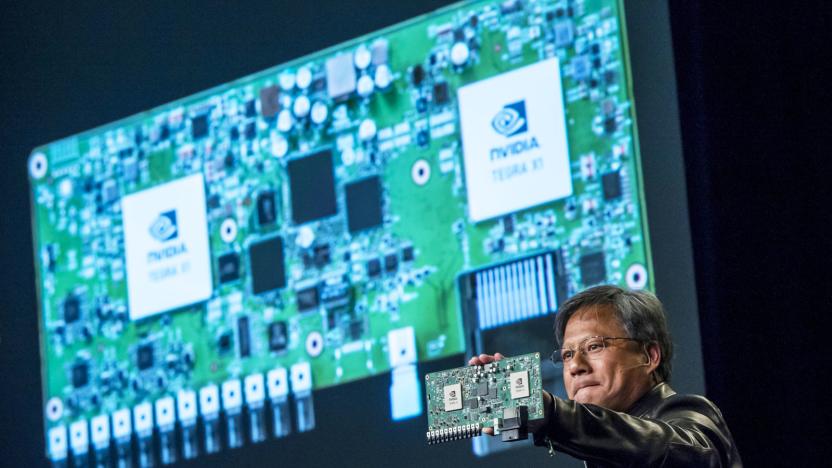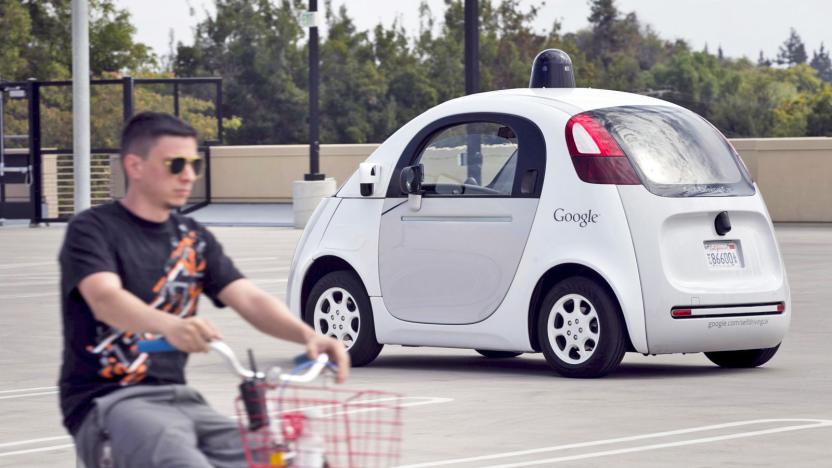autonomousvehicle
Latest

Delphi's autonomous system will be available to automakers in 2019
Automotive supplier Delphi has made a of a habit of showing off its self-driving and other research vehicles at CES in recent years, and 2017 is no different. Except now it's ready to commit to a 2019 launch date for its self-driving suite for automakers. I got to take a ride in a specially outfitted Audi on the streets of Las Vegas and walked away impressed.

Faraday Future unveils an actual car
It's happened. Faraday Future has unveiled its high-tech electric FF 91 SUV. Interested parties can place a refundable $5,000 deposit on the car right now, with production starting in 2018. With a range of 378 miles (it has a 130kWh pack), all-wheel drive, all-wheel turning and 1,050 horsepower, it clearly has the Telsa Model 3 in its sights.

NVIDIA's made-for-autonomous-cars CPU is freaking powerful
NVIDIA debuted its Drive PX2 in-car supercomputer at CES in January, and now the company is showing off the Parker system on a chip powering it. The 256-core processor boasts up to 1.5 teraflops of juice for "deep learning-based self-driving AI cockpit systems," according to a post on NVIDIA's blog. That's in addition to 24 trillion deep learning operations per second it can churn out, too. For a perhaps more familiar touchpoint, NVIDIA says that Parker can also decode and encode 4K video streams running at 60FPS -- no easy feat on its own.

China temporarily bans highway testing of self-driving cars
Self-driving cars are no longer welcome on Chinese highways. At least for now. According to a new report from Bloomberg, the country's auto industry is working with police to create new regulations for autonomous vehicles -- and automakers have been told to keep self-driving vehicles off the road until they go into effect.

Google's self-driving cars can read cyclists' hand signals
Google is working to expand the capabilities of its self-driving vehicle fleet, and according to its latest progress report (PDF), it's making strides in sharing the road with cyclists. One of the ways the folks in Mountain View are doing that is by using onboard sensors to gauge and interpret a cyclist's intent. "Our sensors can detect a cyclist's hand signals as an indication of an intention to make a turn or shift over," the company's June autonomous vehicle report reads. "Cyclists often make hand signals far in advance of a turn, and our software is designed to remember previous signals from a rider so it can better anticipate a rider's turn down the road."

Mercedes Benz's E300 is a luxury car that happens to be high-tech
The Mercedes Benz E-Class has always been fancy. Wood, leather and a sense that you've made some pretty solid life choices are all part of the package. But the automaker has also been on the cutting edge of tech. For example, it added radar-aided adaptive cruise control to its vehicles back in 1998. So it's no surprise that the 2017 E300 is filled to its German gills with the latest and greatest in car technology. The car is indeed impressive, but not without a few hiccups.

China's LeEco teases its very own autonomous electric car
LeEco really wants the world to know it isn't just about TVs and smartphones. After the announcements of its investment in Faraday Future and Aston Martin earlier this year, today LeEco showed off its very first electric car that actually moves. The LeSEE vehicle was driven out of a container from one end of the stage, and later, CEO Jia Yueting did a live demo of its self-driving and self-parking capability using voice commands via a mobile app, albeit moving in low speed due to the limited space, as you can see in the video after the break. There's no mention of specs and the English subtitles suggest that this is more of a concept car at the moment, but it does appear to be a solid start.

The UK wants Google to test its self-driving cars in London
Google's self-driving cars have already racked up more than a million miles, however all of them have taken place in the US. What about other parts of the world, such as those where people drive on the left? According to Sky News, some London officials have been trying to persuade the company to test in Britain for precisely these purposes. The last meeting took place "a few weeks ago," according to Isabel Dedring, London's deputy mayor for transport, following "at least half a dozen" talks over the last three years. Clearly, they haven't been able to work something out.

Baidu will test a self-driving BMW later this year
We've known for a while that Baidu wants its first self-driving car on the road by the end of this year, and now we know who's making that happen. The Guardian reports that the Chinese company is partnering up with BMW, which will provide the testbed for the duo's autonomous car project. The prototype will be used to ensure that the search engine's automotive know-how is safe enough for the public although, like Google's tests, a human will also be along for the ride.

China's Baidu to challenge Google with its own self-driving car
Baidu is often referred to as "China's Google," but it's not quite the same. It's true, the company is working on it's own self-driving car, but it thinks Google's no-wheel design is all wrong. According to Kai Yu, Baidu's Institute of Deep Learning's deputy director, autonomous vehicles need to be more like horses than robots. "A car should not totally replace the driver but should really give the driver freedom," Yu told TheNextWeb. "Freedom means the car is intelligent enough to operate by itself, like horse, and make decisions under different road situations."

Google asks car makers 'Ullo John, wanna self-driving motor?'
Larry Page's tenure as Googler-in-chief has heralded the death of many ambitious experiments, but even he refuses to kill the self-driving car. His project head, Anthony Levandowski, has now asked the car makers of Detroit to sign up with Mountain View for hardware testing, saying that if driverless cars are not ready by the next decade, then it's "shame on us as engineers." There's still some way to go before the tech is road-worthy, but Google is already working with insurers to work out how your car is going to handle making that call to Geico when things go wrong.

Mesa Robotics' mini-tank is perfectly happy on point (video)
The Acer ground-bot from Mesa Robotics does way more than your average 4,500-pound semi-autonomous mule. In addition to carrying kit and providing that extra bit of ballistic steel-deflecting cover, it also scans for IEDs using ground-penetrating radar and then autonomously switches into "flail" mode when it finds one -- digging up and detonating that critter with barely a break in its 6MPH stride. Did we mention it also acts as a landing pad for small drones? No? That's because the video after the break says it all. Cue obligatory guitars, game controllers and armchair gung-ho.

Oxford researchers show off autonomous Wildcat vehicle, no GPS required
BAE Systems has spent years developing an autonomous vehicle based on the rather menacing Bowler Wildcat, but it recently turned the project over to Oxford University, which is now showing off some of the improvements that its researchers have made. Chief among those are a new array of sensors adorning the vehicle, which promise to let it more accurately map out its surroundings and navigate without relying on GPS -- that not only includes monitoring the road (or lack of road, as the case may be), but keeping an eye on traffic patterns and changing conditions, and watching for pedestrians and other obstacles. That's the same basic idea seen from the likes of Google's self-driving cars, of course, although we're pretty sure this could drive over one of those if it wanted to. Head on past the break for some videos showing off the vehicle's capabilities, and hit the source link below for a few more.

Volkswagen Temporary Auto Pilot brings hands-free driving to the highway
Would you feel comfortable driving down the highway with a Temporary Auto Pilot (TAP) behind the wheel of your next Volkswagen? A new technology proposed by the German automaker won't take you from A to B automatically, but it will help out with more simple driving, so you can take your hands off the wheel while cruising down the highway at up to 130km/h (about 80 mph), for example. The system pairs Lane Assist with cruise control, and can be overridden by the driver at any time. The TAP system's Pilot Mode uses radar, laser, camera, and ultrasonic sensors to maintain a safe distance between vehicles, start and stop in traffic, and slow down before a bend. Speed is set by the driver, who you'll need to remain aware of your surroundings in case you need to take over control -- so don't get too comfortable poking around the menus on that AppRadio just yet.

Google's self-driving cars take TED attendees for a wild ride
Google gave folks a brief glimpse at its super secret self-driving cars last fall, but nothing like what it's just showed off at the TED conference that's happening this week in Long Beach, California. The company is not only actually letting attendees inside the autonomous car for a first-hand demonstration, but it's intentionally stepped things up to an "aggressive" level to show just how capable the car really is -- we're talking squealing tires and really tight cornering (all on a closed course, naturally). Head on past the break for a view from both inside and outside of the car courtesy of Search Engine Land.

Google's driverless car drives interest in driverless cars (video)
Self-driving cars are hardly new. We've seen dozens of automatic vehicles over the years, many of which have seen advances driven (so to speak) by various DARPA challenges. But now that Google's involved -- whoa! -- the mainstream media is suddenly whipped into a frenzy of hyperbolic proclamations about the future. Still, it is fascinating stuff to watch. So click on through if you like having your tech salad tossed with a side of smarmy TV-news voiceover. Trust us, it's delicious.

Self-driving taxi picks you up at the press of a button (video)
Who needs safety drivers? Not Germany's Freie University, that's for sure, which has just demonstrated a self-driving taxi to rival Google's efforts without a soul at the wheel. This laser, radar and sensor-equipped VW Passat, dubbed "Made in Germany," has a companion iPad app from Appirion to do all the hard work, too -- you just start the program, punch in coordinates and wait for the car to extract itself from a nearby parking lot and pick you up from school. Ladies and gents, the future is now. Watch it right after the break. [Thanks, Tim]

NC State's computer vision software promises improved self-driving vehicles
Well, NC State researchers sure seem to be keeping themselves busy these days, with them not only recently developing some improved smart sensors, but some computer vision software that could one day lead to self-driving vehicles. The big advantage with their software is that it's basically able to watch the road and recognize real world driving conditions a few steps in advance -- lane changes, stop signs, etc. -- while also watching out for other cars and pedestrians. Of course, at the moment, that "road" is actually the hallways of NC State, and the vehicle is a toy Jeep, but you get the idea. The researchers are also quick to point out that while the software could eventually lead to truly autonomous vehicles, they first see it being used in the event of an emergency, with the car able to slowly and safely pull itself over and then dial 911. Head on past for a quick overview, local news style.

BAE's GA22 unmanned blimp makes its debut, we love blimps
We're not sure what's going on here, but we're not going to complain: Blimps are making a comeback. There are powerful hauling blimps, sure, but BAE is hopping on the autonomous systems bandwagon with its nimble GA22. The 22-meter (72 feet) dirigible is meant to carry high-tech surveillance equipment weighing up to 330 pounds at an altitude around 6,500 feet. The unmanned craft could also be used for sporting events, floods, and forest fires, says BAE. Right now the vehicle is radio-controlled but the ultimate release will be completely autonomous. Unfortunately, this means we can't take a ride, but, as we said, it's still a blimp, and blimps are just straight-up cool.[Via Danger Room]

Japanese use robotic Lassie to pull victims from fires
Ok, so that big hulking autonomous vehicle pictured above looks nothing like little Timmy's bestest bud (except maybe in the later years, when he let the fame get to his head), but Lassie and this yellow Japanese firefighting bot do have one thing in common: no fear of charging into a burning building and pulling out the victims with their jaws or claws, respectively. From the looks of things, these humanitarian-tank-cum-playground-slides are controlled by a remote operator looking through that camera above the headlights -- which is definitely a good thing, because we don't really want robots pinching at us with their hydraulic fingers until machine vision has significantly improved. And of course, team this up with a hosebot, snakebot, or fire-snuffing flower, and you've just obviated the need for millions of firefighters worldwide, as well as crushed the hopes and dreams of countless small, career-minded children.[Via Uber-Review]









